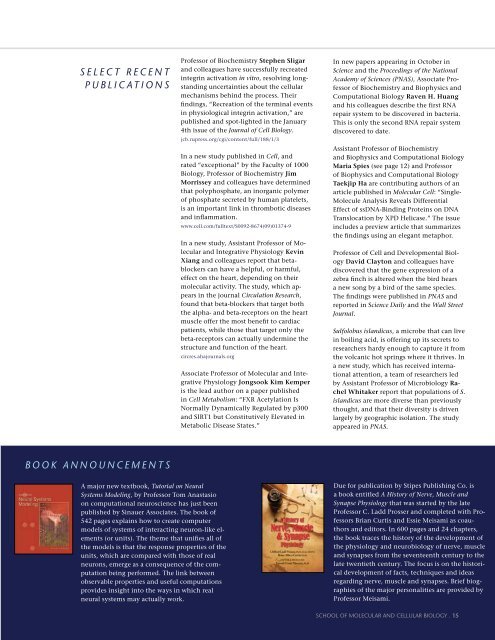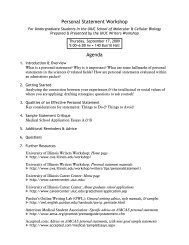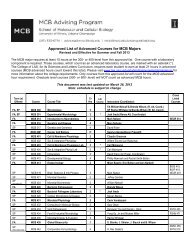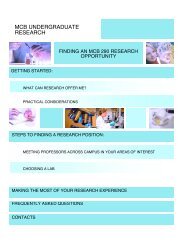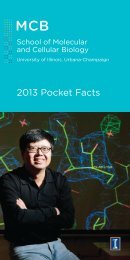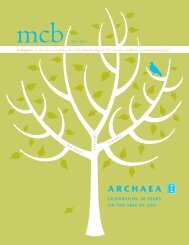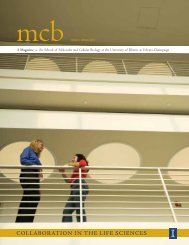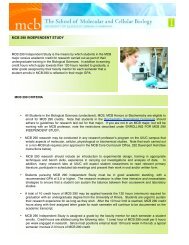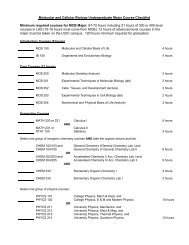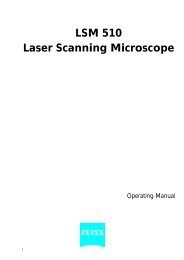breast cancer research • mcb as pre-med - The School of Molecular ...
breast cancer research • mcb as pre-med - The School of Molecular ...
breast cancer research • mcb as pre-med - The School of Molecular ...
You also want an ePaper? Increase the reach of your titles
YUMPU automatically turns print PDFs into web optimized ePapers that Google loves.
Select receNt<br />
PuBlicAtioNS<br />
Book ANNouNcemeNtS<br />
A major new textbook, Tutorial on Neural<br />
Systems Modeling, by Pr<strong>of</strong>essor Tom An<strong>as</strong>t<strong>as</strong>io<br />
on computational neuroscience h<strong>as</strong> just been<br />
published by Sinauer Associates. <strong>The</strong> book <strong>of</strong><br />
542 pages explains how to create computer<br />
models <strong>of</strong> systems <strong>of</strong> interacting neuron-like elements<br />
(or units). <strong>The</strong> theme that unifies all <strong>of</strong><br />
the models is that the response properties <strong>of</strong> the<br />
units, which are compared with those <strong>of</strong> real<br />
neurons, emerge <strong>as</strong> a consequence <strong>of</strong> the computation<br />
being perfor<strong>med</strong>. <strong>The</strong> link between<br />
observable properties and useful computations<br />
provides insight into the ways in which real<br />
neural systems may actually work.<br />
Pr<strong>of</strong>essor <strong>of</strong> Biochemistry Stephen Sligar<br />
and colleagues have successfully recreated<br />
integrin activation in vitro, resolving longstanding<br />
uncertainties about the cellular<br />
mechanisms behind the process. <strong>The</strong>ir<br />
findings, “Recreation <strong>of</strong> the terminal events<br />
in physiological integrin activation,” are<br />
published and spot-lighted in the January<br />
4th issue <strong>of</strong> the Journal <strong>of</strong> Cell Biology.<br />
jcb.ru<strong>pre</strong>ss.org/cgi/content/full/188/1/3<br />
In a new study published in Cell, and<br />
rated “exceptional” by the Faculty <strong>of</strong> 1000<br />
Biology, Pr<strong>of</strong>essor <strong>of</strong> Biochemistry Jim<br />
Morrissey and colleagues have determined<br />
that polyphosphate, an inorganic polymer<br />
<strong>of</strong> phosphate secreted by human platelets,<br />
is an important link in thrombotic dise<strong>as</strong>es<br />
and inflammation.<br />
www.cell.com/fulltext/S0092-8674(09)01374-9<br />
In a new study, Assistant Pr<strong>of</strong>essor <strong>of</strong> <strong>Molecular</strong><br />
and Integrative Physiology Kevin<br />
Xiang and colleagues report that betablockers<br />
can have a helpful, or harmful,<br />
effect on the heart, depending on their<br />
molecular activity. <strong>The</strong> study, which appears<br />
in the journal Circulation Research,<br />
found that beta-blockers that target both<br />
the alpha- and beta-receptors on the heart<br />
muscle <strong>of</strong>fer the most benefit to cardiac<br />
patients, while those that target only the<br />
beta-receptors can actually undermine the<br />
structure and function <strong>of</strong> the heart.<br />
circres.ahajournals.org<br />
Associate Pr<strong>of</strong>essor <strong>of</strong> <strong>Molecular</strong> and Integrative<br />
Physiology Jongsook Kim Kemper<br />
is the lead author on a paper published<br />
in Cell Metabolism: “FXR Acetylation Is<br />
Normally Dynamically Regulated by p300<br />
and SIRT1 but Constitutively Elevated in<br />
Metabolic Dise<strong>as</strong>e States.”<br />
In new papers appearing in October in<br />
Science and the Proceedings <strong>of</strong> the National<br />
Academy <strong>of</strong> Sciences (PNAS), Associate Pr<strong>of</strong>essor<br />
<strong>of</strong> Biochemistry and Biophysics and<br />
Computational Biology Raven H. Huang<br />
and his colleagues describe the first RNA<br />
repair system to be discovered in bacteria.<br />
This is only the second RNA repair system<br />
discovered to date.<br />
Assistant Pr<strong>of</strong>essor <strong>of</strong> Biochemistry<br />
and Biophysics and Computational Biology<br />
Maria Spies (see page 12) and Pr<strong>of</strong>essor<br />
<strong>of</strong> Biophysics and Computational Biology<br />
Taekjip Ha are contributing authors <strong>of</strong> an<br />
article published in <strong>Molecular</strong> Cell: “Single-<br />
Molecule Analysis Reveals Differential<br />
Effect <strong>of</strong> ssDNA-Binding Proteins on DNA<br />
Translocation by XPD Helic<strong>as</strong>e.” <strong>The</strong> issue<br />
includes a <strong>pre</strong>view article that summarizes<br />
the findings using an elegant metaphor.<br />
Pr<strong>of</strong>essor <strong>of</strong> Cell and Developmental Biology<br />
David Clayton and colleagues have<br />
discovered that the gene ex<strong>pre</strong>ssion <strong>of</strong> a<br />
zebra finch is altered when the bird hears<br />
a new song by a bird <strong>of</strong> the same species.<br />
<strong>The</strong> findings were published in PNAS and<br />
reported in Science Daily and the Wall Street<br />
Journal.<br />
Sulfolobus islandicus, a microbe that can live<br />
in boiling acid, is <strong>of</strong>fering up its secrets to<br />
<strong>research</strong>ers hardy enough to capture it from<br />
the volcanic hot springs where it thrives. In<br />
a new study, which h<strong>as</strong> received international<br />
attention, a team <strong>of</strong> <strong>research</strong>ers led<br />
by Assistant Pr<strong>of</strong>essor <strong>of</strong> Microbiology Rachel<br />
Whitaker report that populations <strong>of</strong> S.<br />
islandicus are more diverse than <strong>pre</strong>viously<br />
thought, and that their diversity is driven<br />
largely by geographic isolation. <strong>The</strong> study<br />
appeared in PNAS.<br />
Due for publication by Stipes Publishing Co. is<br />
a book entitled A History <strong>of</strong> Nerve, Muscle and<br />
Synapse Physiology that w<strong>as</strong> started by the late<br />
Pr<strong>of</strong>essor C. Ladd Prosser and completed with Pr<strong>of</strong>essors<br />
Brian Curtis and Essie Meisami <strong>as</strong> coauthors<br />
and editors. In 600 pages and 24 chapters,<br />
the book traces the history <strong>of</strong> the development <strong>of</strong><br />
the physiology and neurobiology <strong>of</strong> nerve, muscle<br />
and synapses from the seventeenth century to the<br />
late twentieth century. <strong>The</strong> focus is on the historical<br />
development <strong>of</strong> facts, techniques and ide<strong>as</strong><br />
regarding nerve, muscle and synapses. Brief biographies<br />
<strong>of</strong> the major personalities are provided by<br />
Pr<strong>of</strong>essor Meisami.<br />
SCHOOL OF MOLECULAR AND CELLULAR BIOLOGY . 15


